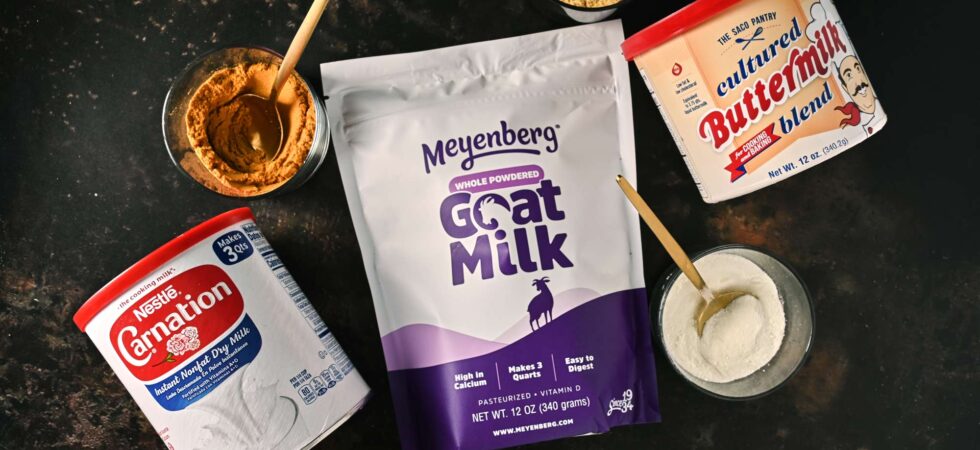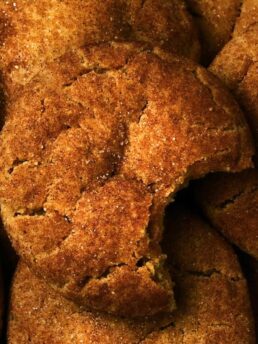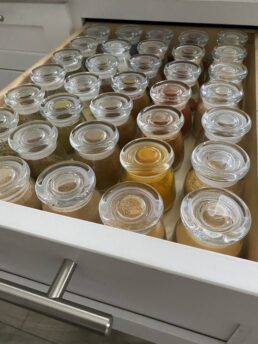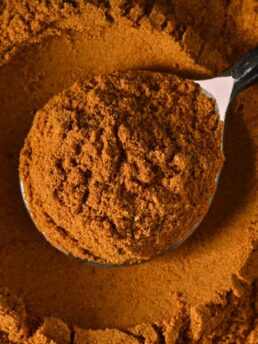Milk Powder: Your Pantry’s New Secret Weapon

Chances are, if you’ve stumbled upon this post you you’re curious about Milk Powder and how to use it in your cooking. It is my hope that this post does three things. Convinces you to:
- purchase and/or make your own milk powders;
- keep milk powders as pantry staples from now on; and
- feel comfortable playing and experimenting with them in your everyday cooking and baking.
You never know. They may become your new secret ingredient; the reason family members and friends can’t get enough of your roasted chicken with extra crispy skin or can’t quite achieve the richness in their cookies as yours.
Don’t believe me? Take it from Chef Christina Tosi, owner of Milk Bar and baker extraordinaire. In an Epicurious interview(1), Chef Tosi says, “she can’t think of a dessert that milk powder wouldn’t improve… “It can make ice creams milkier, denser, silkier—and cookies chewier.” It’s the sort of “secret weapon ingredient”.” And, I say to that…EXACTLY!
Wait, is there more than one kind of milk powder?
You betcha!
For now, I’ll separate milk powders into 2 categories*: animal-based and plant-based, because of the difference in toasting time and technique. Plant-based powdered milks can be further broken down into nuts, seeds, grains, and beans but that’s not important for this post.
Examples of animal-based powdered milks include traditional powdered cow’s milk, powdered goat’s milk, and powdered buttermilk. And, some representatives of plant-based powdered milks would be coconut milk powder, cashew milk powder, almond milk powder, soy milk powder, hemp milk powder, and rice milk powder. Seed milks are becoming more common (e.g., melon seed milk), but they are yet to be produced commercially in concentrated and dehydrated form.
How is milk powder made?
Milk powders are made commercially by dehydrating the milk extracted from cows and goats. The milk product is then atomized into small droplets using high-pressure nozzles and sprayed into a hot air stream. The hot air quickly evaporates the water from the milk droplets, leaving behind fine, dry particles. The dried particles fall to the bottom of the drying chamber, are cooled, and then packaged. From what I can tell, plant-based milk powders are either made as described above. Or, they are simply the powdered pulp of a plant that can be mixed into water to make a glass of “milk”.
According to an article in the Journal of Food Engineering, “Spray drying is the most widely used method for drying of liquid food products including milk and milk products, because of the high moisture removal rate, lower cost, and shorter process time. It also enables the preparation of stable and functional products.”(Jinapong et al. 2008)(2)
Of note: When you shop for plant-based milk powders, be sure to check the ingredient list on the packaging. You should only see the product listed in the ingredients. Sometimes they will also list stabilizers or emulsifiers. That is fine. However, there should not be non-dairy creamer plus nut/bean/seed/grain powder listed on the packaging.
Can you make powdered milk at home?
Sure Can!(3) Dehydrating your own milk powder at home, is possible but time consuming. There are three different options:
Using a dehydrator:
Pour milk onto the silicone dehydrator mats and set the machine to 135°F (57°C). Cook the milk for roughly 12 hours or until it is crumbly and fully dry. You will need to mix and fold the milk around every few hours to redistribute it and break up large clumps as they form. When the milk is fully dehydrated, blend the clumps to form a powder.
Using an oven:
Turn on your oven as low as it will go. Most ovens go as low as 150°F (65°C). Make sure that your oven is either set to convect cook (fan-assisted) or the door is slightly open. These will allow the moisture to evaporate so the milk can reduce and dry out. As with a dehydrator, you will need to mix and fold the milk around every few hours to redistribute it and ensure it doesn’t stick or clump. Blend the clumps to form a powder when done.
Using your stovetop and oven/dehydrator
This option simply reduces the time it takes to make milk powder with one of the above appliances. Pour milk into a stainless steel pan and turn the heat up to medium, medium-low. Let the milk steam but not boil. (NO BUBBLES). Constantly stir until the milk becomes a paste. Once you have a paste, thinly spread it on non-stick surface and proceed with either a dehydrator or oven. Your milk powder is done when it crumbles and no moisture is present. Break up clumps or flakes in a blender until they are powdery.
These methods are best for animal-based milk, but possible for high-fat, plant-based milks like coconut cream. It’s difficult to reduce plant-based milks, as they are more vulnerable to splitting and burning at the the temperatures reached when thickening into a paste. Using just the dehydrator is best for plant-based milks, so you can control temperatures.
Additionally, it can take up to 4 cups (roughly 1 liter) of milk to make about 1/2 cup (50g) of powdered milk, so keep that ratio and cost in mind when determining how much you may need or whether you’d like to try making your own. It could be a great experiment!
What do different milk powders taste like?
The powdered version of different milks have the same flavor profile as the liquid version, but they are slightly more intense because they are concentrated. Here are some quick notes:
Common Animal-Based Milk Powders:
- (Cow) Milk Powder – Powdered milk from a cow has a creamy and mildly sweet flavor, characteristic of fresh cow’s milk.
- Whole Milk Powder – It is made from whole milk, which includes both the milk solids and the milk fat. And, it adds richness and a fuller mouthfeel to recipes.
- Non-fat Milk Powder – It is made by removing the milk fat from whole milk, and keeping only the milk solids. Non-fat milk powder has a leaner taste and a lighter texture (less creaminess) than whole milk powder, but can be used interchangeably.
- Goat Milk Powder – Goat milk powder has a distinctive flavor that is often described as slightly sweet and creamy with a hint of earthiness, much like goat cheese.
- Buttermilk Powder – Buttermilk powder is made by drying the liquid left over after churning butter from cultured cream. It has a tangy and slightly sour taste, adding a pleasant acidity to recipes. (I use this in my snickerdoodle recipe to replace cream of tartar, which I find metallic and overly sharp)
Common Plant-Based Milk Powders:
- Almond Milk Powder – has a nutty and mildly sweet flavor, reminiscent of almonds.
- Coconut Milk Powder – is produced from raw unsweetened coconut cream. It has a rich, sweet coconut flavor.
- Soy Milk Powder – has a mild and neutral flavor, making it the most versatile plant-based option. However, it tends to be thinner in viscosity than other plant-based milk powders when reconstituted.
- Cashew Milk Powder – has a creamy, nutty flavor with a hint of sweetness.
- Oat Milk Powder – is also relatively neutral, with an earthy and lightly sweet taste. Oat milk is naturally dairy-free, gluten-free (check the packaging), soy-free, and nuts-free, making it a very allergy-friendly option. It’s also
*Of Note: Malted Milk Powder kind of falls into both categories, as it is a mixture of malted barley, wheat flour, and whole milk powder. It cannot be toasted in the same way as animal-based powdered milks because of the plant components.
How do milk powders help in baking and cooking?
Milk powder can be used in many baking and cooking applications(4). In truth, animal-based powders are going to perform better, across the board, than plant-based powders. But, I’d like to cover general applications before going over how to choose which powder to use.
Milk Powder’s Baking/Pastry Applications
For baking a safe bet is to add 5% of the flour weight in milk powder per recipe. That is roughly 1 tbsp (6g) of milk powder for every 1 cup (125 grams) of AP flour. For pastry applications that involve cream or custard bases, you can add up to 1 tbsp (6g) of milk powder per cup of wet ingredients — milk, water, cream, honey, and sugar, etc included.
Structure
Some of the proteins in milk powder help strengthen emulsions (a stabilizing interface between oil and water) when mixed into a dough. This stabilization helps doughs rise evenly and contributes to a good texture in breads and other baked goods. Breads, particularly enriched bread doughs, will benefit from the added rise and structure. Cake batters produce a lighter, more aerated crumb. Ice creams take longer to melt. Macarons have more stable shells. And, whipped creams whip thicker and last longer.
Moisture retention
Mixing milk powder into cookie dough and brownie batter provides added chew (protein again) but also increased moisture retention. What does that mean? It means your baked goods will have more body overall, but still remain tender. This happens because the milk proteins gel around water molecules and hold onto more moisture. In a lot of bakery-style cookie recipes, rye flour or bread flour is used to create chew because of their higher protein content (think 13% instead of AP flour’s 11%), but it also makes cookies tougher due to added starch and dry matter. If you are looking for a little extra chew, but still want a gooey center in your cookies, milk powder is your best friend. In ice cream this same phenomena translates to less crystallization and more time before it turns icy. Speaking of…let’s talk about creaminess.
Creaminess
If you add powdered milk to creams it does several things. It increases the ratio of solids to liquids, generally enriching and thickening the mixture. The increase in milk-fat molecules also helps suspend and evenly distribute flavor as it melts or moves across your tongue. This means ice creams, custards, and frosting, etc. will feel creamier in your mouth. And, they will taste better.
Browning
Hello boosted browned butter! (Read the Toasted Milk Powder post for more information.) In most milk powders, toasting creates a caramel-like, malted, and nutty taste. So, it’s a great addition to cookies (like chocolate chip cookies) and caramel. Anything where that nutty flavor is welcome really. It also promotes the Maillard reaction, for deeper color development in things like pie crusts.
Milk Powder’s Cooking Applications
The same ratios apply towards cooking, but you can be looser with your ratios when it comes to sauces or batters. It’s best to build sauces and batters by adding a little at a time until you are happy with the consistency. For dry applications, again, use up to 1 tbsp (6g) of milk powder for every 1 cup (125 grams) of dry ingredients — e.g. flour, cornstarch, and breadcrumbs, etc.
Creaminess (again)
Just like how it benefits sweet sauces like crème anglaise, milk powder adds all sorts of creaminess to soups, sauces, and even casseroles. Any time, you want to increase the richness of something from that list, toss in some milk powder. Creaminess comes from protein emulsifiers (in these cases either lecithin or casein), while the added milk-fat promotes a silkier mouthfeel.
Browning (again!)
You guessed it. Adding milk solids to recipes promotes browning. Essentially, this means crispier crusts and more flavorful food. Consider adding milk powder into the cracker topping of casseroles, the dry ingredients for a breading, and brown butter pan sauces. An increase in the Maillard reaction could be exactly what you need in your next dry rub.
Of Note: If you do decide to use milk powder in a batter, I recommend keeping a firm eye on your oil temperature. While the milk powder promotes deeper color, it will also burn faster, because of the added milk solids. Temperature control is going to be very important.
How do you choose the best milk powder for a recipe?
There are a number of things to think about when deciding which milk powder to use in a recipe.(5) Factors like solubility, cooking technique, protein and fat content, pH balance, and flavor are all great considerations if you are tinkering with a recipe. Here are some thought experiments…
Say you are making a crumble topping for peach cobbler, a nut or grain-based milk powder would be a great option; especially an almond or oat milk powder, to match the flavor profile. YUM. And, nut-milk powders are great for all things crispy and crunchy, because you don’t have to worry about any solubility issues.
If you did want something creamy, solubility and texture become a big deal. For something where silkiness and lightness is important, like whipped cream or pastry cream, a non-fat (cow) or soy milk powder will be your best choices. Solubility is especially important for no heat recipes, like whipped cream or no-churn ice creams. Heat helps break down milk powders and its absence is definitely a limitation on your options. It’s also imperative that the product you use is spray dried. Smaller particles mean a creamier texture.
That doesn’t mean creaminess can’t be attained with nut milk powders. Bring on the heat! If you are making a casserole or pasta dish, factors like flavor and fat content become more important than solubility. So a mac-n-cheese sauce can benefit from both whole milk powder or cashew milk powder. And, while coconut milk powder could also work, because of its high fat content, flavor-wise it might be out of the running for a recipe with cheese. But, adding powdered coconut milk to a crème anglaise, for a coconut ice cream, would be “chef’s kiss”.
If you want more tender pot pie crust or biscuit crumb, buttermilk powder is your powder of choice. Its acidic pH of 4 (milk is around 6.5) along with added moisture retention (protein) is going to work wonders on their texture. In other recipes, however, its flavor can be off-putting. I wouldn’t use it in a merengue anytime soon.
Buttermilk powder can also be used to replace cream of tarter in recipes. I’ve had success using 1 tbsp (6g) of buttermilk powder per 1 tsp (3.2g) cream of tartar. I prefer the tang of buttermilk over the chemical sharpness of cream of tartar. Want a demonstration? Check out my snickerdoodle cookies.
So, here’s to boundless curiosity and new culinary experiments with powdered milk products. thanks for joining me on this milk powder journey. As you know, the party never ends here, so if you want MORE, consider reading about toasted milk powder.
References
- Hopkins, Tiffany. “Milk Powder Is the Key to Better Cookies, Brownies, and Cakes.” Epicurious, 13 Dec. 2020, https://www.epicurious.com/ingredients/milk-powder-baking-cookies-cake-brownie-article. ↩︎
- Jinapong N, Suphantharika M, Jammong P (2008) Production of instant soymilk powders by ultrafiltration, spray drying and fluidized bed agglomeration. J Food Eng 84:194–205. https://doi.org/10.1016/j.jfoodeng.2007.04.032. ↩︎
- Wilson, Linda. “Making Homemade Powdered Milk (with Step-by-step Pics).” The Homesteading Hippy, 25 Oct. 2023, https://thehomesteadinghippy.com/homemade-powdered-milk/. ↩︎
- U.S. Dairy Export Council (USDEC). (2018). Reference Manual for U.S. Milk Powders and Microfiltered Ingredients. Retrieved from https://www.thinkusadairy.org/assets/documents/Customer%20Site/C3-Using%20Dairy/C3.7-Resources%20and%20Insights/02-Product%20Resources/USD5163-US-Milk-Powders_LIVE_Web.pdf ↩︎ ↩︎
- U.S. Dairy Export Council (USDEC). (2018). Reference Manual for U.S. Milk Powders and Microfiltered Ingredients. Retrieved from https://www.thinkusadairy.org/assets/documents/Customer%20Site/C3-Using%20Dairy/C3.7-Resources%20and%20Insights/02-Product%20Resources/USD5163-US-Milk-Powders_LIVE_Web.pdf ↩︎



